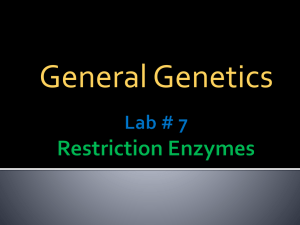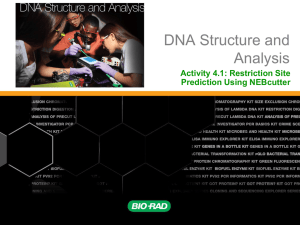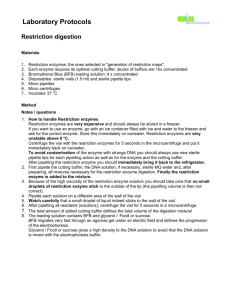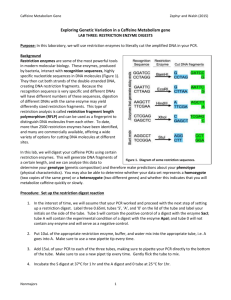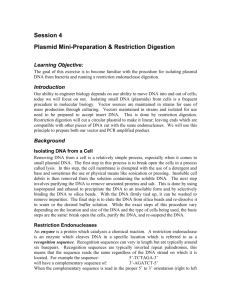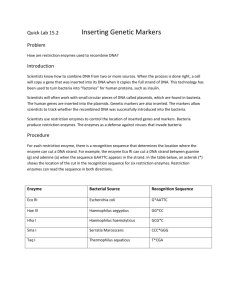Restriction enzyme
advertisement
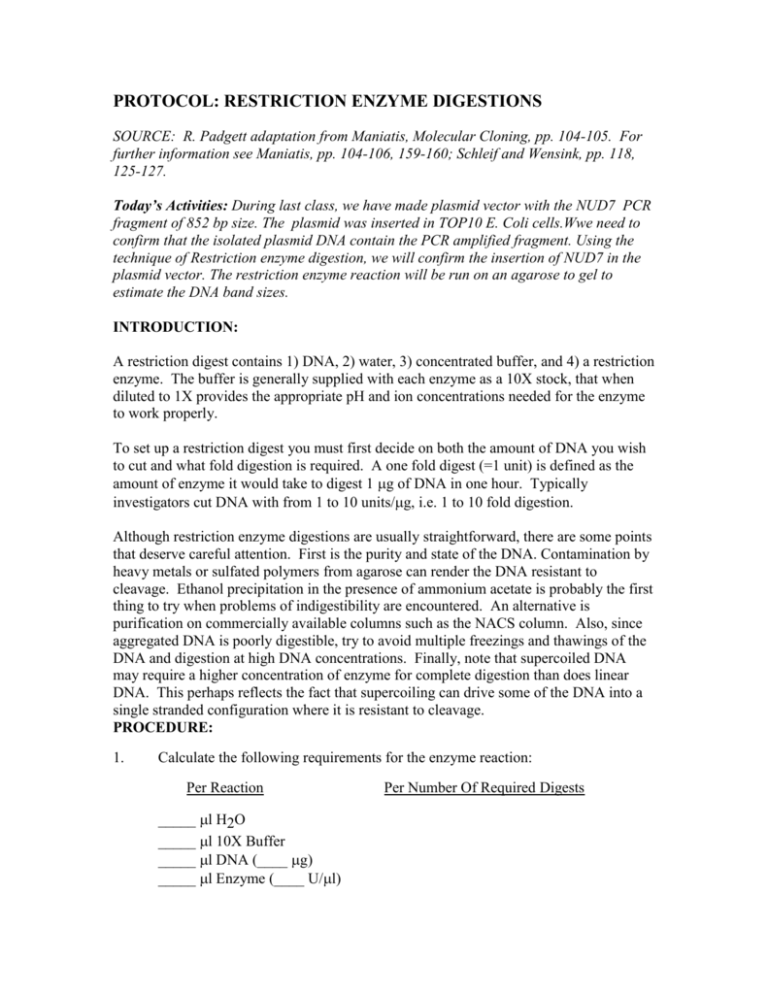
PROTOCOL: RESTRICTION ENZYME DIGESTIONS SOURCE: R. Padgett adaptation from Maniatis, Molecular Cloning, pp. 104-105. For further information see Maniatis, pp. 104-106, 159-160; Schleif and Wensink, pp. 118, 125-127. Today’s Activities: During last class, we have made plasmid vector with the NUD7 PCR fragment of 852 bp size. The plasmid was inserted in TOP10 E. Coli cells.Wwe need to confirm that the isolated plasmid DNA contain the PCR amplified fragment. Using the technique of Restriction enzyme digestion, we will confirm the insertion of NUD7 in the plasmid vector. The restriction enzyme reaction will be run on an agarose to gel to estimate the DNA band sizes. INTRODUCTION: A restriction digest contains 1) DNA, 2) water, 3) concentrated buffer, and 4) a restriction enzyme. The buffer is generally supplied with each enzyme as a 10X stock, that when diluted to 1X provides the appropriate pH and ion concentrations needed for the enzyme to work properly. To set up a restriction digest you must first decide on both the amount of DNA you wish to cut and what fold digestion is required. A one fold digest (=1 unit) is defined as the amount of enzyme it would take to digest 1 g of DNA in one hour. Typically investigators cut DNA with from 1 to 10 units/g, i.e. 1 to 10 fold digestion. Although restriction enzyme digestions are usually straightforward, there are some points that deserve careful attention. First is the purity and state of the DNA. Contamination by heavy metals or sulfated polymers from agarose can render the DNA resistant to cleavage. Ethanol precipitation in the presence of ammonium acetate is probably the first thing to try when problems of indigestibility are encountered. An alternative is purification on commercially available columns such as the NACS column. Also, since aggregated DNA is poorly digestible, try to avoid multiple freezings and thawings of the DNA and digestion at high DNA concentrations. Finally, note that supercoiled DNA may require a higher concentration of enzyme for complete digestion than does linear DNA. This perhaps reflects the fact that supercoiling can drive some of the DNA into a single stranded configuration where it is resistant to cleavage. PROCEDURE: 1. Calculate the following requirements for the enzyme reaction: Per Reaction _____ l H2O _____ l 10X Buffer _____ l DNA (____ g) _____ l Enzyme (____ U/l) Per Number Of Required Digests 2. Mix water and buffer (10%). Gently finger vortex. If all the reactions are identical this can be done as one batch and aliquoted to individual tubes. 3. Add appropriate DNA solution to each tube 4. Add appropriate number of units of a restriction enzyme, and finger vortex. Again, one unit of enzyme is usually defined as the amount required to digest 1 g of some standard DNA to completion in 1 hour in the recommended buffer and at the recommended temperature in a 50 l reaction. In general, digestion for longer periods of time or with a modest excess of enzyme does not cause problems unless there is contamination with DNase or exonuclease. (Such contamination is rare in commercial enzyme preparations.) 5. Incubate at the appropriate temperature for the time required. 6. Stop the reaction by the addition of 0.5M EDTA (pH 7.5) to a final concentration of 10mM and/or heat to 65oC for 10 minutes. (Some restriction enzymes are not inactivated by heat and may require phenol extraction). If the DNA is to be analyzed directly on a gel, add gel-loading dye, mix, vortex briefly, spin one second in microfuge, and load the digest into the gel slot. NOTE: Reactions typically contain 0.2-1 g of DNA in a volume of 20 l or less. MATERIALS: 1. 10X Digestion buffers 2. Restriction enzymes (0.5-1.0 l/reaction) 3. DNA 4. 37oC water bath 5. Microfuge and microfuge tubes Cloning Site of Entry Vector showing EcoRI cut site. Map of Entry Vector:


